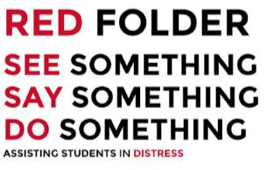Red Folder: Assisting Students in Distress
Pasadena City College (PCC) has created a new electronic resource entitled, the Red Folder, to assist faculty and staff identify, respond, and refer students in distress. It contains safety tips and contact information for a wide variety of emergency campus resources for immediate assistance to any student in distress.
The Red Folder serves a quick reference guide to:
- Identify and better understand the signs of psychological distress exhibited by students;
- Address student issues (behavioral, psychological, personal threatening and safety; and
- Intervene with appropriate support staff if you suspect that a student or other community member may needed assistance.
 The Red Folder was adapted from an initiative created by the University of California
(UC) system. In collaboration with the UC, the California State University System
(CSU) developed a workshop of peer health educators and counselors to develop a program
to meet the needs of the CSU and its students.
The Red Folder was adapted from an initiative created by the University of California
(UC) system. In collaboration with the UC, the California State University System
(CSU) developed a workshop of peer health educators and counselors to develop a program
to meet the needs of the CSU and its students.
PCC recognizes that students seek support and counseling from faculty and staff members whom they have fostered a trusting relationship. For this reason, PCC is providing a tool that will assist its faculty and staff in connecting students with the appropriate campus services.
For further assistance, please call Mental Health & Wellness at (626) 585-7273.
Signs and Symptoms of Psychological Distress:
- Change in academic performance or behavior
- Peer performance and preparation
- Excessive absences or tardies
- Repeated requests for special treatment
- Unusual or change interaction
- Avoids participation
- Dominates discussions
- Anxious when called upon
- Disruptive of class
- Reports roommate or family problems
- Exaggerated emotional responses
- Strange behaviors showing loss of contact with reality
- Isolated from friends or family
- Depressed or lethargic mood
- Hyperactive or rapid speech
- Unusual appearance: swollen or red eyes, change in hygiene or dress, dramatic change in weight
- References to suicide, homicide, or death
- Statements of helplessness or hopelessness
Tips for Assisting Students in Distress
- Request to speak with the student in private
- Talk directly and honestly to the student
- Inquire if the student is speaking to anyone regarding the problem (e.g., family or friends). Isolation is rarely useful for those in distress.
- Listen to thoughts and feelings in a sensitive, non-threatening way
- Show you understand. Repeat back the essence of what the student has told you. Include both content and feeling
- Avoid evaluating and criticizing even if the student asks your opinion.
- Respect the student’s value system, even if you disagree with it.
- Do not ignore strange or inappropriate behavior.
- Do not discuss concerns with other students.
- If you initiate contact, use nonjudgmental terms. For example,
"I've noticed you've been absent from class lately and I am concerned," rather than "Where have you been lately? You should be more concerned about your grades."
"It sounds like you are not accustomed to this much work and you are worried about failing."
